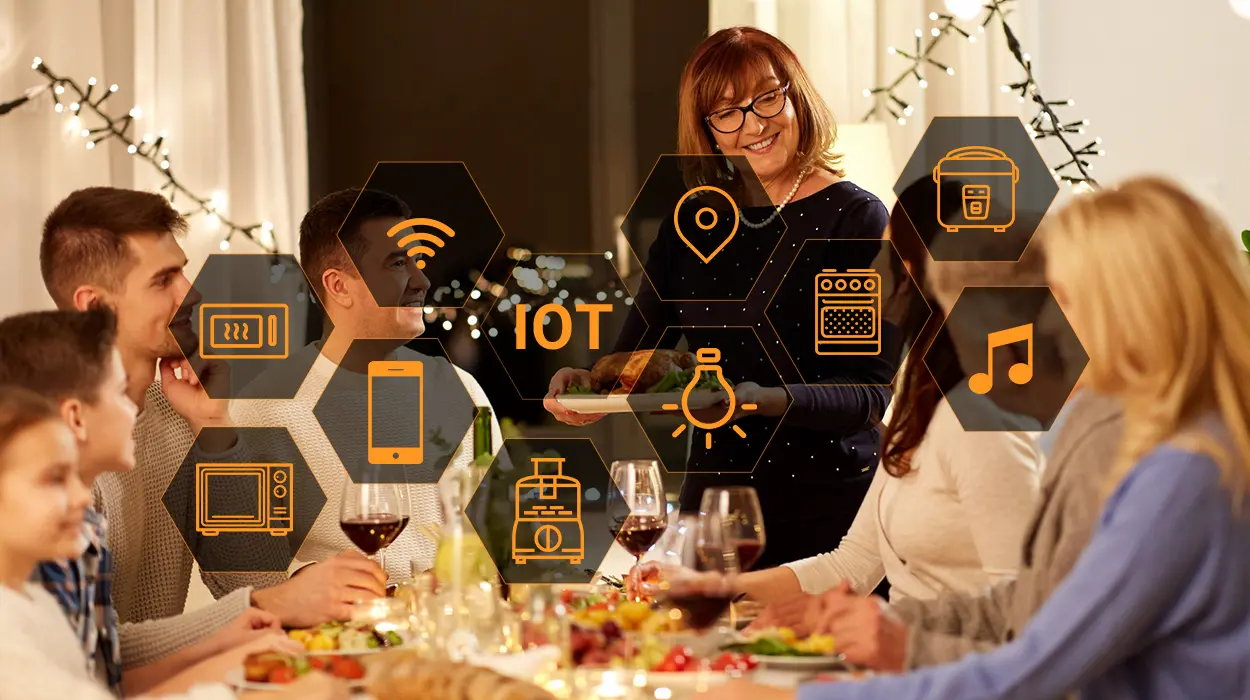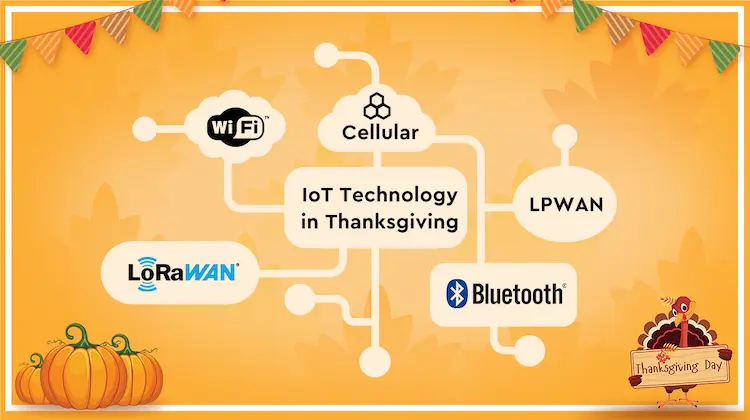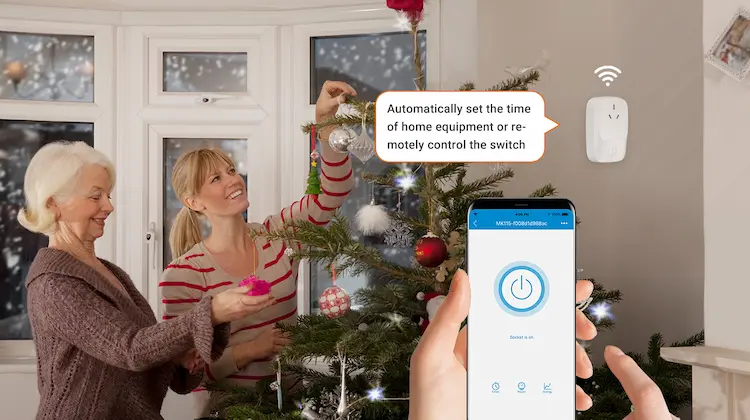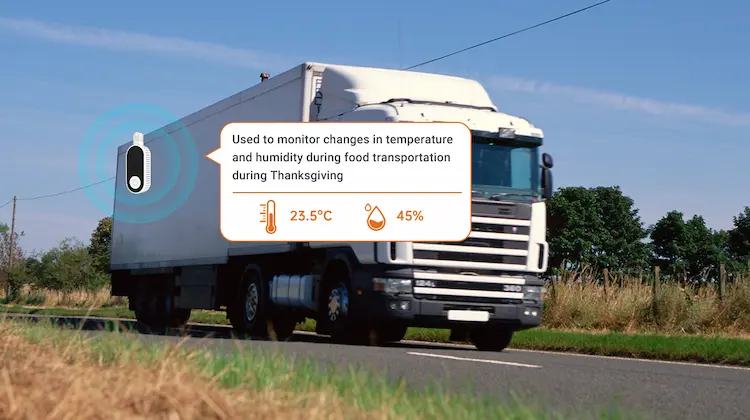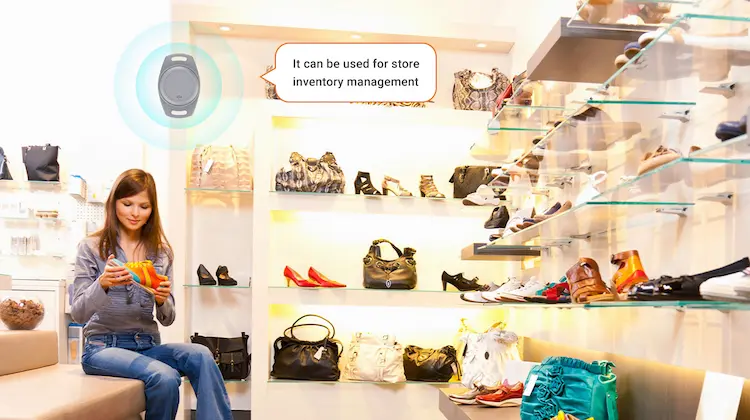Internet of Things (IoT) is a network of items that are physical, and are termed as ‘things’. They have sensors, and software which makes it possible to communicate with these physical devices through the internet. The sophistication of these IoT in Thanksgiving devices ranges from simple domestic items to sophisticated industrial equipment.
The prediction of analysts indicates that by 2025, there will be above 22 billion that are connected to IoT devices.
President Abraham Lincoln did not designate a national Thanksgiving Day until 1863 when the country was in the midst of the Civil War.
Despite the additional help from all of the family members pitching in, running things around the house, especially when you’re the host, may be exhausting on days like these. Thanks to the Internet of Things solutions have revolutionized our kitchens and living spaces.
As IoT technology pervades more and more product categories from smart light switches to smart IoT beer bottles consumers look for intelligent items that are efficient, convenient, and simply enjoyable to own. IoT technology has a plethora of possible uses that might improve your vacation.
From real-time turkey telemetry to smart kitchen management to asset tracking to obtain a greater understanding of stray relatives, there’s something for everyone.
Types of IoT Technology in Thanksgiving
Let’s take a look at the key alternatives available today before we get into how to pick which technology is suitable for you. This technology includes:
Cellular: Cellular is one of the most well-known forms of IoT wireless technologies, especially in the consumer mobile industry. Cellular networks offer dependable internet connections for anything from streaming video to voice conversations. Because cellular is so well-established, it provides a lot of bandwidth. Carriers are offering Cat-M1 and NB-IoT cellular choices to compete with new LPWAN technologies. Cellular performs well in low-power situations, particularly when used with Cat-M1. Cellular is also a fantastic solution for non-mobile applications when electricity isn’t an issue.
BLE (Bluetooth Low Energy): This technology is a popular wireless tech among consumers. It is a communication technology that works within a short range and is categorised under the wireless personal network (WPAN). It is suitable for consumer IoT with small scale applications. This technology is used to transfer data between smartphones, fitness and medical wearables including smartwatches to smart home devices. They are exceptionally good at communicating across short distances.
WiFi: WiFi is another well-known IoT wireless technology that has played a significant role in offering high-throughput data transfer in households and for businesses. It has considerable limits in terms of scalability, coverage, and high power consumption, yet it may be highly useful in the proper settings. IoT devices should not be connected to the same major Wi-Fi networks as conventional staff PCs or phones, due to updated business security procedures. In Zipit’s experience, this has encouraged more OEMs to turn to other technologies, such as cellular, to address these security problems while also speeding up deployment.
WiFi is generally not a suitable alternative for big networks with battery-operated sensors, which include smart buildings and industrial applications, as a result of its high energy consumption. Instead, smart home appliances and other technologies are more effective. WiFi 6, the most recent WiFi technology, does enhance bandwidth and speed, but it still lags behind other accessible solutions.
LPWAN: Low-power wide-area networks (LPWAN) (Cat-M1/NB-IoT) requires only small and affordable batteries to provide long-range connection. This technology family is suited for enabling large-scale IoT networks that require a substantial range. LPWANs, on the other hand, can only transfer tiny data blocks at a slow rate.
LPWANs are appropriate for applications that do not require a large bandwidth or temporal sensitivity, such as a water meter. It’s also suitable for environmental monitoring as well as facility management. Keep in mind that network security, interoperability, and dependability are all dependent on standards. LPWAN, a newer technology, is gaining prominence.
LoRaWAN: LoRaWAN is a cutting-edge technology with lots of potentials. It’s comparable to Bluetooth, but with a larger range and lower battery usage for tiny data packets. All linked devices’ communication frequencies, and data rate are controlled by LoRaWAN. To deliver data to the cloud, LoRaWAN sensors interact with a cellular gateway. Backhaul transit is required, and partners like Zipit can offer essential cellular assistance.
LoRaWAN and LPWAN share similar use cases, since they don’t require any significant bandwidth for transmission of data. However, LoRaWAN is distinct in key aspects. It’s a wireless point-to-point connection with no direct Internet connection, whereas LPWAN is a direct-to-internet link.
LoRaWAN sensors may be widely distributed over a big region because of their long range. These sensors are simple and intended to transmit tiny data packets rarely, making them suitable for irrigation control, leak detection, and transportation management, and asset monitoring. Keep an eye on the LoRaWAN network as it develops.
How can MOKOSmart IoT devices be applied in Thanksgiving:
IoT kitchen utensils have joined a slew of smart-home gadgets that might turn your IoT Thanksgiving 2021 feast into a worthy gourmet experience. Here are some MokoSmart IoT devices:
IoT in Thanksgiving Kitchen Smart Plugs: Cooking a huge lunch is both the most fun and the most tiresome aspect of the thanksgiving anniversary, But with MOKOSMart wifi smart plug sockets, a smart home gadget that transforms your standard electrical into a smart, controlled, and multi-functional device that allows you to quickly manage your lights, other electronic devices and also helps to schedule your cooking time. Set schedules or timers to switch on or off the connected devices depending on your habits and preferences at any time. Set a timer to turn on the electric kettle so you may sip a cup of hot water as soon as you get up, and a countdown to switch off USB phone charging at night to avoid overcharging. Your smartphone can be used to control the appliances in your home, just from any location and at any time.
IoT in Thanksgiving Smart Home: IoT in Thanksgiving MOKOSmart plug can also operate your home devices with voice commands rather than having to walk up to them. Supports one-click sharing with your family, eliminating the need to repeatedly connect and set up. Set a timetable for your electronic gadgets, such as stereos, strings, bulbs, humidifiers, electric kettles, Christmas trees, coffee makers, lamps, and electric fans, to switch on and off automatically as needed. You can also combine all of your smart gadgets and operate them with a single command. The H4-Pro Sensor iBeacon may also be used to track temperature and humidity changes to maintain a pleasant environment. You can do this by inserting the smart plug into an outlet, connecting to an existing Wi-Fi network, and connecting a device to the smart plug. Then operate your household equipment from anywhere you want remotely, using the APP Smart Life.
IoT in Thanksgiving Food: The beef of a juicy turkey has been cooked properly when it gets to an internal temperature of 165°F. The MOKOSmart Temperature and Humidity Sensor provides some fast cook time suggestions, but every oven and, more importantly, every turkey is different. Connecting your food to the cloud can help you create a more delicious feast. This is also a good technique to tell whether hot food is safe to serve if your visitors have a habit of rushing into eating and scorching their tongues. MOKOSmart Bluetooth beacons may also be used to track precious items to reduce food transit delays. It may be used both indoors and outdoors to keep track of inventories and other critical business functions.
IoT in Thanksgiving Store: The MOKOSmart Bluetooth beacon is used for navigating in the mall, locating desired items, and inventory checking by employees. MOKOSmart beacon lets everyone within its range readily see where it is, and it may also be used to track precious objects. It may be used both indoors and outdoors to keep track of inventories and other critical business functions. Beacons may be used to track people and send individuals who are close to the location, as well as to enable workers to readily discover products in the warehouse and to easily identify and locate automobiles being sent to potential consumers.
IoT in Thanksgiving Tourism: IoT can be functional in the daily operations of hotels and travel agencies. Smart technologies can assist improve the physical condition of a hotel and its rooms while also lowering energy bills. Sensors might potentially be deployed on flights to inform flight attendants when passengers’ anxiety levels rise over a specific threshold. With the MOKOSmart Bluetooth beacon, a notice might be sent to passengers while they’re traveling by places, allowing them to have more control and access to information about each place via their phone.
Other IoT Applications in Thanksgiving
Every November, we take time to appreciate those who have had an impact on our lives. Thanksgiving is a holiday that is dedicated to spending memorable time with your family, reflecting on our blessings, and eating turkey. To make this Thanksgiving the best it can be, I’ve compiled a list of the five Internet of Things devices that can take it to the next level:
Bluesmart Suitcase: Thanksgiving brings together almost 46 million Americans. As a result, a large number of bags are packed and transported throughout the country. You wouldn’t want your vacation to be disrupted by missing luggage. The Bluesmart luggage, on the other hand, has come to save the day. You’ll have real time information about the location of your clothing and prompts that make sure you don’t forget any of them. All of these benefits are available in the Bluesmart and many more.
June Oven: This IoT 2021 Thanksgiving, more than 46 million turkeys will be roasted and eaten, accounting for approximately 20% of all turkeys farmed throughout the year. It becomes an all-day event if you’re in charge of one of the numerous turkeys. What is the goal? To ensure that the family and friends receive the best possible bird. With its linked oven, the June oven seeks to alleviate the suffering. June allows you to manage and monitor the cooking of your meals from your smartphone. This ensures that you’re never far from your oven, with a built-in camera that identifies the food. June will then weigh it and make a recommendation for a culinary program. The pressure of preparing an ideal dinner is eased with the June oven.
Precision Cooker by Anova: For a long time, commercial kitchens have been able to do this type of cooking, but it’s a bit of a stretch for the ordinary home chef. The Anova is attempting to make it as simple as possible for everybody to benefit from the cooking process. It allows you to convert any pot into a state-of-the-art sous vide machine with ease. The Anova business even experimented with the proper technique to sous vide turkey as a bonus.
Smart Coffee Table: There is a lot of entertainment to be done when folks gather together for Thanksgiving. Kids will get to do some fun things during supper. Duet Multitouch Coffee Table appears to be the ideal complement. Consider your niece playing Angry Birds on a 40-inch touchscreen coffee table.
Nest Cam: Having cameras on vacation isn’t anything new. The new Nest Cam has some nice features, which enables you to take photos with your phone from anywhere. Perhaps even more thrilling is the potential to transform your memorable day into a time-lapse film that you can share with the rest of the world.
Conclusion
Every day, more linked IoT devices are released. There are still many potentially beneficial items available. See what else is available and choose your favorites.
